Last update 29-03-2018
Bahrain Amiri Air Force / Royal Bahraini Air Force / حماة العز سلاح الجو الملكي البحريني
سلاح الجو الملكي البحريني
Credit: Roundels of the world
Last update 06-04-2024
DESIGNATIONThe title Royal Bahraini Air Force was adopted when the country was renamed Kingdom of Bahrain on February 2002.
PROCUREMENT
A first request for information was made by the defence minister to the local US ambassador in September 1976 regarding the Northrop F-5B, F-5E, F-5F as the country was planning to set up an Air Wing within
5 to 7 years.
The Bahraini Defence Forces (as originally named) were still equipped only with helicopters, when the worsening situation in the Gulf area prompted the government to seek combat aircrafts and develop an air
defence capability.
On early 1982 the US government offered Northrop F-5E and F-5F for about USD 180 million, but, before acceptance, the offer was amended in September 1982 to read 4 Northrop F-5G Tigersharks (later called
F-20A) and 2 F-5F; Bahrain was not prepared to be the launch customer for the new Northrop F-5G. After studying alternatives (such as the GAMD Mirage 2000 BAe Hawk) a later US offer of 4 Northrop F-5E,
2 Northrop F-5F
and 60 AIM9-P-3 Sidewinders was accepted and a firm order placed in February 1982. Ten US government and three US contractor personnel were involved for technical support and to train local technicians and
pilots for 2 years, at a total cost of USD 14 millions. A second contract, valued USD 92 million, was placed during Februray 1985, again for 4 F-5E and 2 F-5F plus 15 spare General Electric J-85 engines.
New infrastructure to operate the fighters had to be built, pilots were to be trained and an early warning radar system, part of a Golf Coordination Council regional integrated air defence system, had to be established.
Some helicopter pilots underwent advanced training with the Royal Saudi AF and joning Saudi units to gain further experience, while others were sent to the USA to follow an advanced weapons and tactics course on F-5
at Williams AFB with the 425th Tactical Flying Training Sqn.
By March 1987seven pilots had also undergone air-to-air training at General Electric's Center for Advanced Airmanship at Phoenix, Arizona (a private fighter pilots training company). This course included emergency and
hostile situations, comprising 20 hours of simulator experience.
Finally, Bahrain enterd the jet age in October 1985 with the acceptance of the first Tiger. Delivery started on December 1985: 2 Northrop F-5E (serials 681/682) and 2 Northrop F-5F (serials 641/642) were air delivered,
via Keflavik, Prestwick (arrival December 6th), Alconbury, Nice, Kerkira, Tabuk to Manama International Airport; next were F-5E 683/684 and F-5F 643/644, transiting Prestwick on September 12th, 1986 and departing
Alconbury on September 16th 1986; F-5E 685/686 followed on December 8th 1986 at Prestwick and F-5E 687/688 on January 21st, 1987, again at Prestwick .
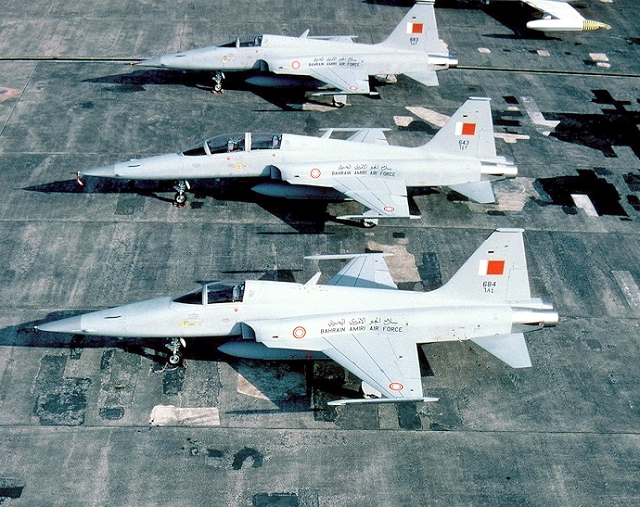
F-5E 683, 684 with F-5F 643 resting on the Prestwick apron on September 12th, 1986
Starting in 1987 a new Air Base, called Shaikh Isa AB, was built in the South of Bahrain's main Sintra Island at a cost
of USD 100 million, to accomodate the fighters, provisionally based at Manama International Airport, on the island of
Muharraq, a former Royal Air Force base. This was completed by May 1990. The base also housed 8 Lockheed-
Marting F-16C Block 40 and 4 Lockheed-Martin F-16D Block 40, the first having arrived on 23-05-90 to supplement
the Northrop fighters.
From 2010 new pilots were attached to the Lockheed-Martin F-16 from the Hawk trainer, bypassing the intermediary
Tiger step
BASES - UNIT
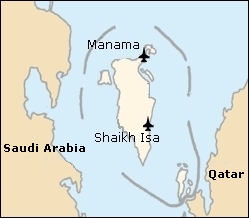
The 6th Tactical Fighter Squadron "Fighting Sharks" (Serials page code: 6 Sqdn) was formed on arrival of the first F-5s, at Manama International
Airport, moving in June 1989, upon completion of the base, to Shaikh Isa AB.
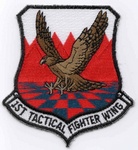
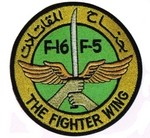
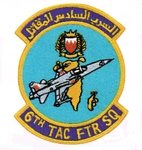
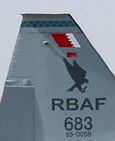

Official badge and patch 1st TFW; badge 6th TF Sqn; aircrafts tail inscription/flag by mid-2000; badge worn 2014
Close co-operation was arranged with the Royal Saudi Air Force regarding pilot training (training up to F-5 level), the use of Saudi air space (due to the very limited Bahraini air space - 128 by 64 kms) and the use
of nearby Saudi bombing ranges to practise live firing of air-to-ground and air-to-air weaponry.
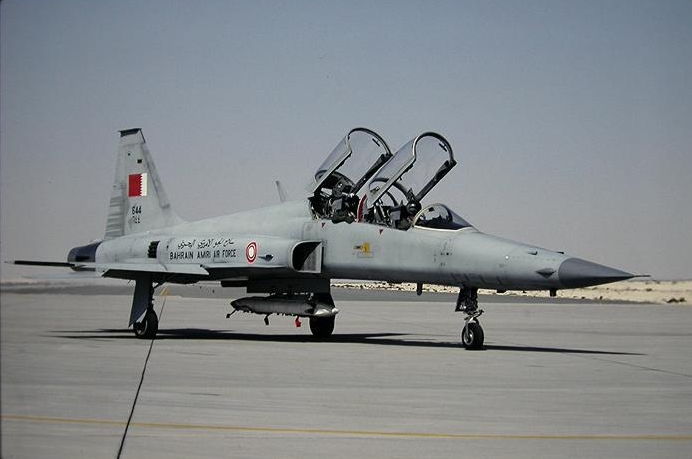
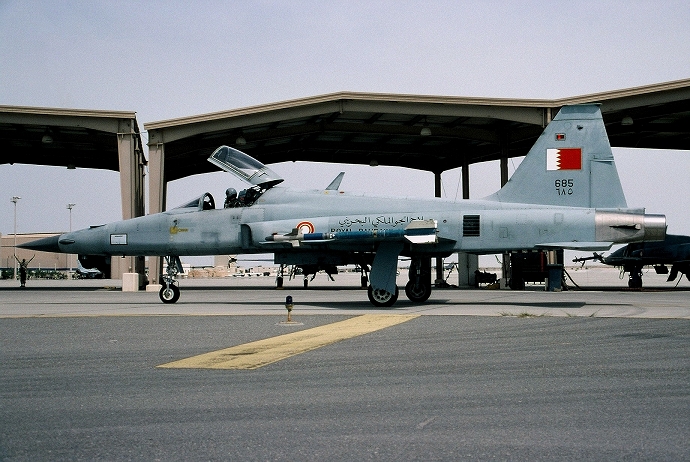
F-5F serial 644 1994 with Bahraini Amiri AF titles and rocket launcher Photos: Northrop F-5 Enthusiast archives F-5E 685 with Royal Bahraini AF titles July 2004
WAR OPERATIONS
Baptism of fire for the newly established Squadron came with "Desert Storm" war against Iraq occupying Kuwait.
The F-5s carried from January 25th 1991 defensive mission and from the 26th interdiction missions - around three to four per day, often teamed with Bahraini F-16s, acting as escort fighters. BAAF F-5s attacked a
wide range of Iraqi targets in Kuwait, including radar and communication sites, artillery positions and Silkworm missile sites with 500 lbs Mk82 bombs, totalling 127 combat sorties without losses.
EXERCISES/TRAINING
Normal operation started after the Gulf war, including participation to multinational exercises, like "Peninsula Tiger 2" in Qatar in January 2001, with the partecipation of 5 Bahraini F-5s, 5 Omani Hawks, 6 Saudi F-15s,
5 Kuwaiti F-18s, 6 United Arab Emirates Mirage 2000, Qatari Mirage 2000s and Alpha Jets.
The same year saw for Bahraini Northrop F-5s and General Dynamics F-16s the exceptional opportunity to exercise against US Navy F-14 Tomcats assigned to Fighter Squadron (VF) 32.
Continous yearly exercises are held involving forces belonging to members of the Gulf Cooperation Council, like "Peninsula Hawk" and "Gulf Spears".
Northrop F-5s have been continously upgraded and optimised for the ground attack role, including anti-shipping, while dissimilar air combat training is often flown against local F-16s. Additionally they have at present
a useful training commitment; Tiger pilots fly at least 300 hours before being taken into consideration for conversion to the F-16C/D of the 1st or 2nd Fighter Squadron at Sheikh Isa AB. In Close Support Missions
excercise protect the Lockheed-Martin F-16 the upper space, their radar illuminate the targets for the Tgers. The Northrop F-5s is a feared enemy during Dissimilar Air Combat Training due theit low radar echo and
their agility.
In 2010 four new pilots were attached each year to the 6th Squadron while American direct contract (not USAF) pilots perform Instructor Pilot duties.
The 6th Fighter Squadron participated also to the 14th "Initial Link" exercise from the 11th till the 22nd May 2008, together with Bharaini F-16s from the 1st and 2nd Squadron plus Saudi AF BAE Tornado IDS
(83 Squadron), McDonnell F-15C (13 Squadron), Kuwait AF F/A18C (25 Squadron), Quatar AF Mirage 2000-5 (7 Squadron), UAE AF F-16E (1/2 Squadron).
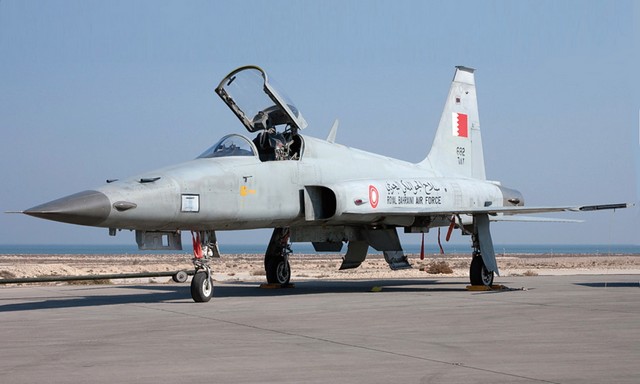 Photo: Arno Gravemaker
Photo: Arno GravemakerNorthrop F-5E 682 seen at Isa AB on 01-11-10
Northrop F-5s have some operational duties but are mainly used as fighter Lead-in trainers (300 hours) for new pilots coming from basic training on BAe Hawk and proceding to the Lockheed-Martin F-16.
A photo taken by a satellite on 20-04-13 at the Sheikh Isa AB shows all 12 Northrop F-5s lined-up, confirming that no aircrafts had been lost.
Joint excercise "Gulf Shield" took place in 2018 from King Abdullahaziz AF (Saudi Arabia) with the participation of Northrop F-5, Pakistani JF-17, Gulf States F-15, F-16, F-18s, Tornados and Typhoon.
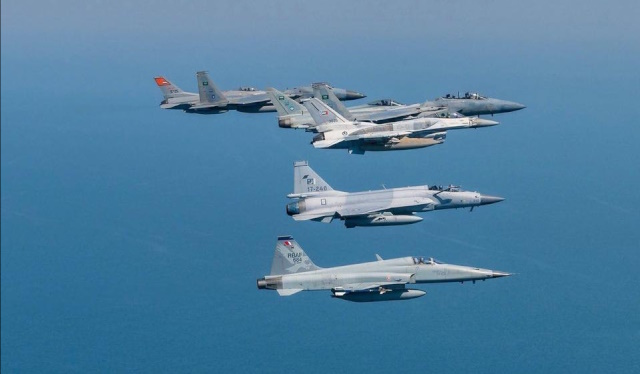
Northrop F-5E serial 684 with its excercise partners.
UPDATE/REPLACEMENT
In the late 1990's the Tigers received an update, details unknown.
A rather unusual deal was proposed by the US Navy during April 1995. Eighteen former aggressor Lockheed-Martin F-16N and TF-16N, withdrawn from use during 1994, were to be exchanged against 12 Bahraini F-5s,
but Bahrain preferred to buy 12 new Lockheed-Martin F-16C/D Block 40, later supplemented by an additional 10 F-16C Block 40, but keeping its Northrop F-5s and leading to the formation of the 1st Tactical Fighter Wing.
The Tigers were kept operational. The Tigers participated in 2008 to the excercise named "Initial Link' 08", betwen 11 and 22 May 2008 with the participation of all Gulf Cooperative Council (Kuwait, Oman, Qatar, Saudi
Arabia and United Arab Emirates) Air Forces. This excercise is held biennally since 1988 but it is not if Tigers particpated to other editions.
The February-March 2012 edition of "Initial Link" was held again, including over 100 aircrafts from the participating countries: Saudi Arabia, UAE, Oman. Kuwait, Jordan, Egypt, Turkey, Pakistan and the USA
They were present at the excercise "North Thunder" held on February-March 2016, in conjunction to Egyptian F-16 Block 15s, United Emirites Mirage 2000-9s, Kuwaiti F/A Hornets plus various helicopters and transpor
aircrarafts.
Search for a Tiger replacement started in 2010; candidates have been, as usual, Lockheed-Martin F-16, Boeing F-18, Dassault Rafale, BAE Eurofighter. This last was to have a chance as neighbour Saudi Arabia already uses
it; anyhow there have been discussions in August and November 2013 to continue air training without the Tigers. The Lockheed-Martin F-16V-70 was chosen in June 2018 and 16 aircrafts were orded (deliveries started
but by 2019 the original Bhraini aircrafts were still in use.
By 2021 it is not known if Bahraini Tigers are still operational. A picture of the first two-seat Lockheed-Martin F-16V-70, handed over on 10-30-23, shows an eagle painted on the tail, the same as the one of the 6th Tactical
Fighter Squadron, meaning probably re-equipment of the unit.



